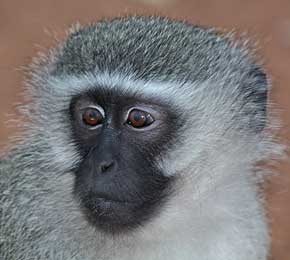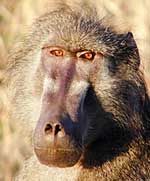Contact Details: Scotch Macaskill, Dirt Road Traders, Currys Post Road, Howick, KwaZulu-Natal, South Africa. Tel: +27 (0)82 578 2329. Privacy: Your privacy is guaranteed. See our Privacy Policy for more. This site accepts advertising and other forms of compensation - see Disclosure and Advertising for details. Site updated: 2022. Copyright © 2002 - 2022 Scotch Macaskill

| ||||||||||
|
||||||||||
|
See also info about: |
Vervet Monkey Information
Vervet monkeys are the most common monkey of the African savanna, found throughout the continent from Senegal to Sudan and all the way down to the southern tip of Africa. Unlike other African primates that have remained in the equatorial rain forests, the vervet has come down from the trees and adapted instead to wooded habitats outside of the rain forests. Although it no longer lives in the trees, it never ventures too far from the safety of wooded areas. For those on safari in Africa, the vervet monkey is commonly sighted, either on the ground foraging for food or moving around in trees. If you should come across a troop of vervet monkeys, it's well worth spending some time watching their behavior and group interactions rather than racing off to find the next big cat, although this is seldom possible because of time constraints. Appearance:
The face is relatively flat compared to that of another commonly sighted primate, the chacma baboon (right), which has a pronounced, dog-like muzzle. Baboons are also considerably larger and heavier, with adult males weighing up to 45 kg (100 lb). The vervet monkey's underparts are lighter in color than the uppers, while the black face is fringed with white hair across the forehead and down the sides of the cheeks. The hands and toes are also black. The adult male has a distinctive blue scrotum. There is some overall color variation among vervet troops, depending on their area of origin. Behavior:
Each vervet monkey troop comprises a complex hierarchy of families whose members sleep, forage and rest together. Within each troop there are separate dominance hierarchies among males and females. Dominant males are favored as mates by the females, while dominant females get better access to resources. The dominant male maintains his status with grimacing and threatening gestures. While males leave their home troop at adolescence to join other groups, females stay in the troop and a mother's rank predetermines her daughter's. Even adults in a family must submit to juveniles of families with higher social status. Vervet monkeys, like other primates, spend much time grooming each other. This is done to clean and neaten the fur and to get rid of insects like ticks and fleas. Grooming is also a way of bonding between individuals and reinforcing the pecking order within the troop. Reproduction:
The babies are cared for by all the females in the troop, even the immature ones. Although males usually ignore infants, the whole troop will rush to rescue a baby if it is in danger. The infant spends the first week of life clinging to its mother's stomach and does not sit astride the mother's back, jockey fashion, as do young baboons. Diet:
They also eat small invertebrates and, occasionally, vertebrates such as lizards or nesting birds. Vervets forage in a well-defined home range, with the troop dispersing over a sizeable area, moving slowly on a broad front. They are known to raid crops and gardens and in urban areas can become a nuisance, entering homes through open windows to grab any available food. Sounds:
To find out more about vervet monkeys, see our Monkey Pictures Gallery. Return to Wildlife Info . |
|||||||||
|
|
||||||||||

 Vervet monkey has a black face fringed with white
Vervet monkey has a black face fringed with white



